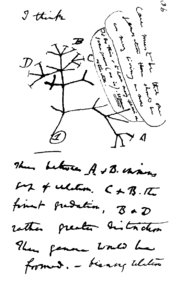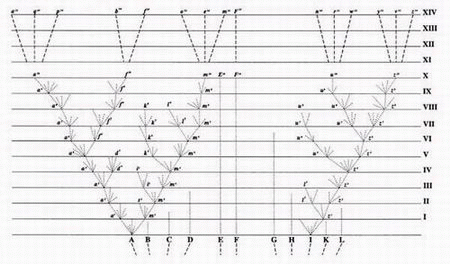
Page from Darwin's notebooks around July 1837 showing his first sketch of an evolutionary tree. (via Wikipedia)
| The Phylogenetic Tree | ||
| Systematics | Darwin's Tree |
| Linnaean taxonomy | Evolutionary systematics |
The following is for now copied verbatum from Wikipedia
 Page from Darwin's notebooks around July 1837 showing his first sketch of an evolutionary tree. (via Wikipedia) |
Charles Darwin (1809-1882) was the first to produce an evolutionary tree of life. He was very cautious about the possibility of reconstructing the history of life. In On the Origin of Species (1859) Chapter IV he presented an abstract diagram of a theoretical Tree of Life for species of an unnamed large genus (see figure). On the horizontal base line hypothetical species within this genus are labelled A - L and are spaced irregularly to indicate how distinct they are from each other, and are above broken lines at various angles suggesting that they have diverged from one or more common ancestors. On the vertical axis divisions labelled I - XIV each represent a thousand generations. From A, diverging lines show branching descent producing new varieties, some of which go extinct, so that after ten thousand generations descendants of A have become distinct new varieties or even sub-species a10, f10, and m10. Similarly, the descendants of I have diversified to become the new varieties w10 and z10. The process is extrapolated for a further four thousand generations so that the descendants of A and I become fourteen new species labelled a14 to z14. While F has continued for fourteen thousand generations relatively unchanged, species B,C,D,E,G,H,K and L have gone extinct. In Darwin's own words: "Thus the small differences distinguishing varieties of the same species, will steadily tend to increase till they come to equal the greater differences between species of the same genus, or even of distinct genera." (Darwin 1859, pp. 116-130).] This is a branching pattern with no names given to species, unlike the more linear tree Ernst Haeckel made years later (figure below) which includes the names of species and shows a more linear development from "lower" to "higher" species. In his summary to the section as revised in the 6th edition of 1872, Darwin explains his views on the Tree of Life:
 The Tree of Life image that appeared in Darwin's On the Origin of Species by Natural Selection, 1859. It was the book's only illustration (via Wikipedia) |
The affinities of all the beings of the same class have sometimes been represented by a great tree. I believe this simile largely speaks the truth. The green and budding twigs may represent existing species; and those produced during former years may represent the long succession of extinct species. At each period of growth all the growing twigs have tried to branch out on all sides, and to overtop and kill the surrounding twigs and branches, in the same manner as species and groups of species have at all times overmastered other species in the great battle for life. The limbs divided into great branches, and these into lesser and lesser branches, were themselves once, when the tree was young, budding twigs; and this connection of the former and present buds by ramifying branches may well represent the classification of all extinct and living species in groups subordinate to groups. Of the many twigs which flourished when the tree was a mere bush, only two or three, now grown into great branches, yet survive and bear the other branches; so with the species which lived during long-past geological periods, very few have left living and modified descendants. From the first growth of the tree, many a limb and branch has decayed and dropped off; and these fallen branches of various sizes may represent those whole orders, families, and genera which have now no living representatives, and which are known to us only in a fossil state. As we here and there see a thin straggling branch springing from a fork low down in a tree, and which by some chance has been favoured and is still alive on its summit, so we occasionally see an animal like the Ornithorhynchus or Lepidosiren, which in some small degree connects by its affinities two large branches of life, and which has apparently been saved from fatal competition by having inhabited a protected station. As buds give rise by growth to fresh buds, and these, if vigorous, branch out and overtop on all sides many a feebler branch, so by generation I believe it has been with the great Tree of Life, which fills with its dead and broken branches the crust of the earth, and covers the surface with its ever-branching and beautiful ramifications. (Darwin 1872, pp. 104-105)
page MAK130328 Material by MAK Creative Commons License; other material as stated.